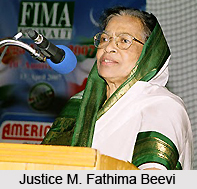REPRESENTATION OF WOMEN IN THE LEGAL PROFESSION
By Adrita Shah
The article talks about the reasons why representation of women in the legal profession was not huge and the present status of Supreme Court judges.The legal profession in India is of high importance. Previously there were very few women opting for this profession but now there seems to be a change.
Cornelia Sorabji was the first female advocate of Allahabad in 1921.The legal profession had thrown open its doors to the female population of India. Formally, after the passing of the Legal Practitioners’ (Women) Act, XXIII of 1923 abolishing the bar on women from practising Law, Indian women were granted the right to take up the legal profession and practice as Advocates in the Courts of Law. Cornelia Sorabji had pioneered the fight for justice for the ‘’pardanashin’’ women of her times, who on account of their ignorance and lack of formal education could be easily deceived by the legal men or their touts. They could not seek assistance from male Advocates in the event of disputes simply because they were men .Initially only a few women joined the profession as Advocates. This reformative measure ignited the spirit of pleading for the cause of another before the Courts. Perhaps the realisation had set in; in the pre-independent era that freedom from “slavery” if it was possible could be obtained through educating women The British rule had established schools, colleges and Universities for women by the 1860s in India, but they did not have access of it until the 1920s and hence it stopped them from possessing such skills which would make them decision makers in society.[1]

The Constitution of India has given all its citizens the right to equality and the right against discrimination on the basis of their gender from acquiring any education or practising any profession of their choice. In spite of this right, the Legal profession did not become a popular choice for women, simply because they weren’t given education. Education wasn’t received by them due to many reasons such as poverty, stringent caste restrictions, restrictive social customs, and cultural practices condemning the working of women outside their homes.
the Indian Judiciary was active in its encouragement of women who took up the legal profession and went on to appoint the first woman Judge Hon’ble Justice Anna Chandy to Kerala High Court. Justice Anna Chandy had started her career as an Advocate in 1929 and had been appointed a Munsiff in 1937 thus becoming the first Woman Judge in pre-independent India. These two decades also saw the entry into the legal profession of two eminent lawyers who went on to become Hon’ble Justice Leila Seth and Hon’ble Justice Fathima Beevi Chief Justices of Himachal Pradesh and Kerala High Courts respectively. The former had been an actively practising advocate in the Delhi, Kolkata and Patna High Courts for more than 15 years and the latter had risen from the position of a Munsiff and had retired as a Supreme Court Judge eventually. Curiously, over the years the representation of women has not increased in the Judiciary corresponding to the initial number of women Judges. The situation is such that there has been a demand of 33% reservation for women in the Judiciary to bring about parity between the numbers of male and female judges. [2]

Since 1970s women have chosen legal profession and have become successful Advocates, Academicians, legal aid workers or volunteers and draftsperson, judiciary etc , and from the past 10 years, a phenomenal growth , in number of women joining law and legal practice can be seen. They have become a part of the legal profession whether it is advocacy or judiciary or draftsperson or etc. Meera Sahib Fatima Bibi inspired thousands of life by being the first woman judge in Supreme Court in India.

The Growth of women in the legal profession can be seen from the under mentioned table
| Years | Total registered practitioners | Women practitioners | Percentage |
| 1962-1997 | 136,635 | 4,265 | 3.12 |
| 1998-2005 | 91,509 | 7,346 | 12.3 |
| 1962-2005 | 228,144 | 11,611 | 5.08 |
From the above table, it can easily be propounded that the % of women from 3.12 has increased to 5.08 in 40 years which does not denote very good growth but it implies a increasing growth.[3]
The profession of law has been a male dominated field since 19th century in India. Women were denied the right to practice law until High Court of Allahabad took lead and allowed Miss Cornelia Sorabji in 1921 to practice law. Since then, though the number has increased yet, not many women joined the bandwagon. It was only after 1970s that number of female legal practioners increased. The profession in recent times has attracted a large number of women in India to study law. The number of female legal practioners is less. Further, women faced a lot of problems in practicing in court and thus, the profession itself drives less number of women. There does not seem to be gender discrimination as both female and male candidates are given equal opportunity to appear in competitive examination. As far as higher judiciary is concerned, there has been sort of discrimination because collegiums have recommended only few female names. There are a few safeguards that can be adopted by the females of our society. Article 14 and Article 15(3) of the Indian Constitution empowers the State to make special provisions for women and children. India is a signatory to Conventions on Elimination of Discrimination Against Women (CEDAW), 1979, which envisaged removal of obstacles of women’s public participation in all spheres of public and private lives.” [4]

Since independence, only 6 women judges have been elevated to Supreme Court out of total 229 judges. Out of 29 Supreme Court judges, only one judgment has been given by a female judge –justice R Banumathi. There are only 63 woman judges whereas 611 male judges. When the Supreme Court Women Lawyers Association brought these facts to the attention of the constitution bench it initiated the process of improving the collegiums alleging a gender bias and discrimination against women in appointment. The issue also figured in the suggestions given to the court by legal luminaries and was compiled by senior counsel Arvind Datar and ASG Pinky Anand. “There is an urgent need to increase the number of women judges. The percentage is very low in most High Courts”, it said.
End Notes
[1] http://www.legalservicesindia.com/article/article/representation-of-women-in-the-legal-profession-in-india-2285-1.html accessed on 13.4.17
[2] I.B.I.D
[3] http://legalamicus.com/category/research/ accessed on 13.4.17
[4] http://www.gktoday.in/iaspoint/current/under-representation-of-women-in-judiciary-in-india/ accessed on 16.4.17


